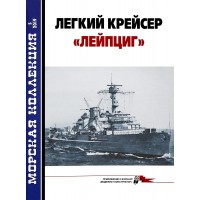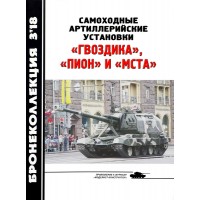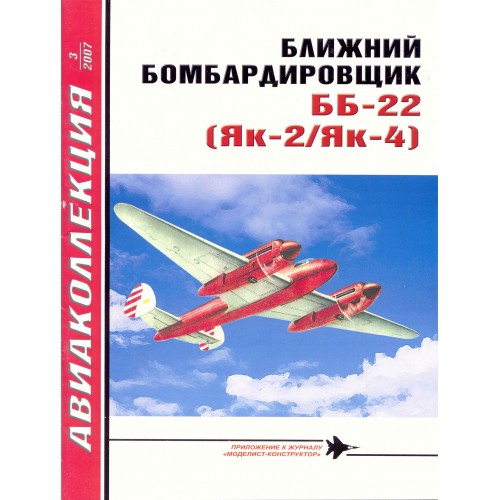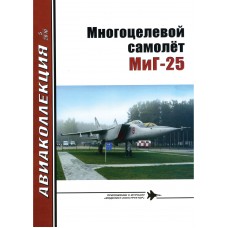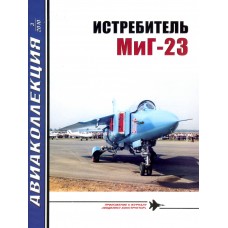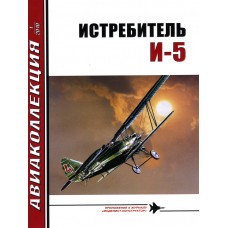AKL-200703 AviaCollection / AviaKollektsia 03/2007: Yakovlev BB-22 (Yak-2/Yak-4) Soveit WW2 Light Bomber. Photos, schemes, colour pictures. 32 pages, soft cover, text in Russian.
In February 1939, at the Moscow Central Aerodrome named after Frunze, a beautiful twin-engine two-keel monoplane appeared. Red and white color, rapid forms involuntarily attracted attention to him. Hidden in streamlined engine nacelles, powerful 12-cylinder engines with propeller cocks protruding far beyond the nose of the fuselage provided the vehicle with excellent power-to-weight ratio. It was clear to the experienced eye that the aircraft could show very high flying qualities.Even without knowing the brand of the plane, no one doubted that it was designed in the experimental design bureau (OKB) of Alexander Yakovlev - a young but already quite famous aircraft designer at that time, the author of a series of training and "business" light-engine aircraft. Yakovlev was the first of the Soviet designers to ensure the "recognition" of their prototypes. Perfectly finished, meticulously painted and polished to a shine, they all bore the "signature" red and white stripes on the rudders.Factory tests of the aircraft, which received the designation "Airplane No. 22" in the Design Bureau, were carried out by Yulian Piontkovsky, one of the most experienced pilots in the country, who soon became Yakovlev's chief pilot. Evgeny Adler was appointed the leading engineer of the machine. So much was expected from "aircraft number 22" that even at the testing stage it attracted the attention of the Red Army Air Force command and I.V. Stalin.
CREATING A PLANE
Waiting for the imminent war
In the 1930s military aviation was the "favorite toy" of the top leaders of the USSR. Huge funds were allocated for its development, grandiose air parades and record flights were organized to popularize it. Numerous facts of the "departure" of the sons of the most prominent Soviet leaders to this area of science and technology testify to how prestigious a career associated with aviation was.Powerful aviation research institutions appeared in the country, carrying out research in the interests of design bureaus and aviation enterprises. The efforts of the giant industry soon bore fruit. In the first half of the 1930s. I-15 and I-16 fighters, SB high-speed bombers were created and adopted. The USSR became the only power in the world with an entire fleet of heavy TB-3 bombers... At the initial stage of the Spanish Civil War, Soviet fighters and high-speed bombers showed their best qualities and undoubtedly surpassed the Franco aircraft.However, at the turn of 1937 - 1938. crashes began. The "first bell" sounded when Hitler sent his newest Bf 109 fighters to Spain. These aircraft, piloted by experienced German pilots, made a tough competition to the I-16 monoplane, not to mention the outdated I-15 biplane. SB bombers lost their most important trump card - superiority in speed over enemy fighters - and began to suffer significant losses. This situation turned out to be unexpected for the Soviet aviation specialists and Air Force leaders, although at its core it concealed a strict pattern.In the second half of the 1930s. in England, Germany and the USA a new generation of aircraft engines was created, which surpassed their predecessors' in terms of power by 50-100%. Needless to say, the flight performance of aircraft with such engines has improved markedly.The maximum speed of the fighters exceeded 500 km / h, with the best of them it began to approach 600 km / h. Noticeable, albeit less impressive, progress was also observed in bombers.The Paris Aviation Exhibition, held in 1938, turned out to be a record for the number of new generation combat aircraft presented. One of the ideas that gained great popularity among aircraft manufacturers at that time was the concept of a twin-engine high-speed multi-purpose monoplane aircraft. Such a machine could perform the functions of an escort fighter, a close reconnaissance aircraft and a light bomber. The bias towards preference for "fighter" or "reconnaissance-bomber" qualities largely determined the appearance of the equipment being created.So, in France, Pote 63 and Breguet 691 were built, which later became serial. These machines were more attack bombers than fighters. The Germans and Poles considered the most important features of the "multipurpose aircraft" to be their destructive properties: this is how the Focke-Wulf FW 187, Messerschmitt Bf 110 and PZL-38 "Wilk" ("Wolf") appeared.
AKL-200703 AviaKollektsia N3 2007: Yakovlev BB-22 (Yak-2/Yak-4) Soveit WW2 Light Bomber magazine
- Brand: AviaCollection / AviaKollektsia
- Product Code: AKL-200703 In Stock
-
$3.90
Available Options
Look at these products too:
AKL-201005 AviaKollektsia N5 2010: Mikoyan MiG-25 Soviet High-Supersonic Multipurpose Aircraft magazine
AKL-201005 AviaKollektsia N5 2010: Mikoyan MiG-25 Soviet High-Supersonic Multipurpose Aircraft magaz..
$3.90
AKL-201001 AviaKollektsia N1 2010: Polikarpov I-5 Soviet Biplane-Fighter magazine
AKL-201001 AviaCollection / AviaKollektsia series 1/2010: Polikarpov I-5 Soviet Biplane Fighter. Pho..
$3.90



